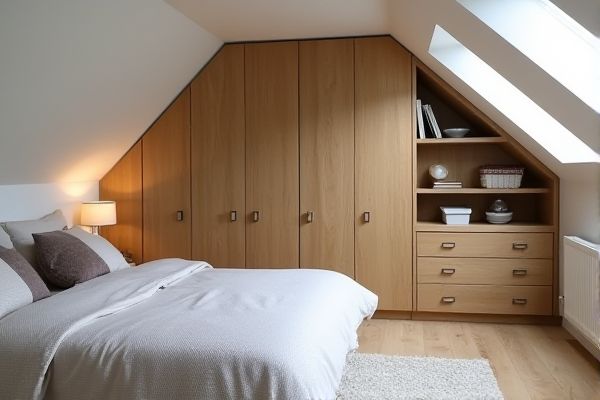
Knee wall storage maximizes space by utilizing the short walls under sloped ceilings, offering easy access for smaller items, while dormer storage creates more vertical space with built-out window areas, ideal for larger or more accessible storage needs. Discover which storage solution best fits Your attic or room by exploring the detailed comparisons ahead.
Table of Comparison
| Feature | Knee Wall Storage | Dormer Storage |
|---|---|---|
| Location | Along short wall under sloped ceiling (knee wall) | Within a dormer projection extending from roof |
| Space Utilization | Utilizes low-height, narrow spaces | Expands usable space with added headroom |
| Headroom | Limited, typically low clearance | Increased headroom due to dormer design |
| Design Complexity | Simple to construct, minimal structural changes | Complex, requires roof modification |
| Natural Light | Usually none or limited | Often includes windows for natural light |
| Cost | Lower cost due to simplicity | Higher cost due to construction complexity |
| Storage Capacity | Moderate, suited for smaller items | Larger, suitable for bigger storage needs |
| Accessibility | Restricted by low height | Better accessibility with full headroom |
Understanding Knee Wall Storage
Knee wall storage utilizes short walls typically found under sloped ceilings, creating efficient, low-height compartments perfect for stashing seasonal items or shoes. Unlike dormer storage, which expands usable space by adding vertical walls and windows, knee wall storage maximizes tucked-away areas within existing architecture. Understanding knee wall storage helps you optimize small spaces without extensive renovations, enhancing organization in attics or upper-floor rooms.
What Is Dormer Storage?
Dormer storage refers to the built-in storage space created within a dormer, an architectural feature that extends vertically from a sloping roof, providing additional headroom and natural light. This type of storage maximizes otherwise underutilized attic or loft areas by integrating shelves, cabinets, or drawers along the dormer's walls. Your use of dormer storage can enhance functionality in rooms with sloped ceilings by offering both accessible and visually appealing storage solutions.
Space Utilization: Knee Wall vs Dormer Storage
Knee wall storage maximizes space by utilizing the lower, often underused area beneath sloped ceilings, providing efficient compartments ideal for smaller items and seasonal storage. Dormer storage capitalizes on vertical space created by windowed projections, offering deeper, more accessible storage areas that enhance natural light and room functionality. Comparing the two, dormer storage typically delivers better overall space utilization in terms of volume and accessibility, while knee wall storage excels in making use of narrower, constrained spaces.
Installation and Construction Differences
Knee wall storage involves building a short wall, typically 3 to 4 feet high, perpendicular to the slope of the roof, creating space between the wall and the floor for storage; this method requires framing, insulation, and drywall work within attic or upper floor spaces. Dormer storage installation requires constructing a vertical windowed extension projecting from the sloping roof, which demands more extensive modifications to the roof structure, including cutting rafters and adding new framing, roofing, and siding. Your choice between knee wall and dormer storage depends on the level of structural alteration you're willing to undertake and the desired increase in usable headroom and natural light.
Cost Comparison: Knee Wall vs Dormer
Knee wall storage generally offers a more budget-friendly solution with lower construction and finishing costs due to its simpler framing and reduced material needs. Dormer storage typically incurs higher expenses because of additional structural work, roofing modifications, and increased labor for complex installation. Homeowners often choose knee wall storage to maximize space efficiency while minimizing overall project costs compared to the premium pricing of dormer storage options.
Accessibility and Usability
Knee wall storage offers easy accessibility due to its lower height and placement along short walls, making it ideal for storing frequently used items within arm's reach. Dormer storage provides more vertical space and better usability for larger or bulkier items, as it extends out from the roof and creates additional headroom. Your choice depends on whether you prioritize quick access or maximizing storage volume in an attic or loft area.
Design and Aesthetic Impact
Knee wall storage offers a minimalist design that seamlessly integrates with sloped ceilings, creating clean lines and maximizing space without disrupting room flow. Dormer storage enhances natural light and expands usable area, adding architectural interest and a sense of openness that can elevate the overall aesthetic. Your choice depends on whether you prioritize discreet functionality or a visually dynamic feature that contributes to the room's character.
Insulation and Energy Efficiency
Knee wall storage typically offers better insulation as it often incorporates thicker wall cavities that reduce heat loss, enhancing your home's overall energy efficiency. Dormer storage spaces can have more complex insulation challenges due to their protruding design, which may create thermal bridges and increase heat transfer. Properly insulated knee wall storage helps maintain consistent indoor temperatures, reducing energy costs compared to less efficient dormer storage areas.
Pros and Cons of Knee Wall Storage
Knee wall storage offers efficient use of low-height attic spaces by providing built-in shelves or cabinets along short walls, maximizing otherwise unused areas. Your key advantage is increased storage without sacrificing floor space, but the limited height restricts accessibility and bulky item placement. This type of storage is ideal for organizing smaller items and maintaining a clean appearance, though it may require custom solutions to fully optimize its potential.
Pros and Cons of Dormer Storage
Dormer storage offers increased headroom and natural light, making spaces feel more open and usable, especially in attics or upper floors. However, it can be more expensive to build due to additional structural modifications and potential roofing changes. You may find dormer storage less suitable for maximizing floor area compared to knee wall storage, which uses lower, tucked-away spaces efficiently.
 homyna.com
homyna.com